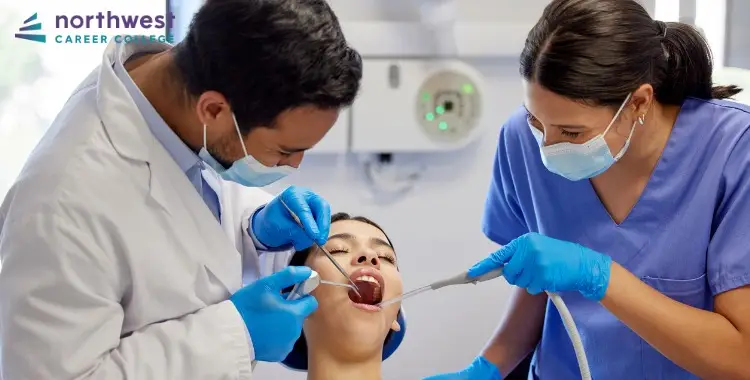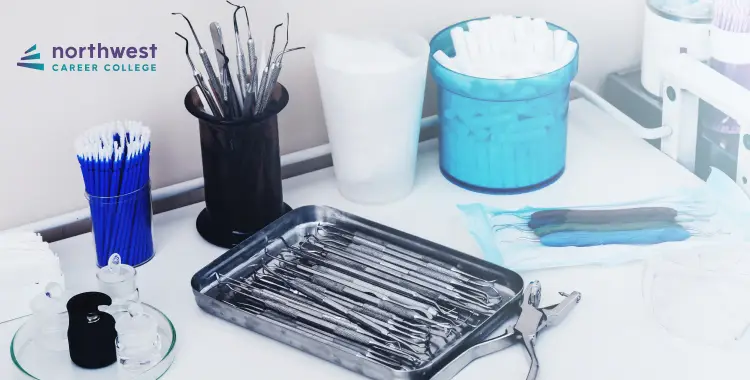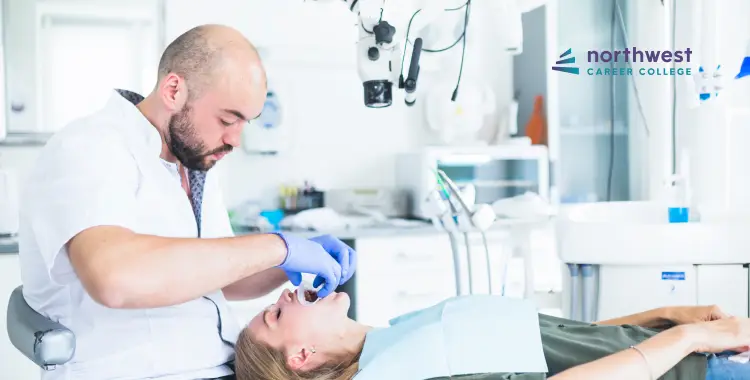A Guide To Infection Control For Dental Assistants – Part 1
- September 18, 2024
- 3.0k views
- 5 min read

Dental procedures performed by dental assistants play a crucial role in the healthcare industry, offering patients essential oral health services. Given the nature of dental work, which often involves direct contact with saliva and blood, infection control is critical to ensuring the safety of patients and dental practice staff.
Since the importance of infection control cannot be understated, dentists generally consider the comprehensive knowledge of industry-standard infection control practices a prerequisite for dental assistants entering the field.
Since there are many factors to keep track of in a fast-paced dental office, individuals new to the dental field typically have a leg up on the competition if they complete a dental assistant training program at an accredited institution before seeking employment.
This multi-part article will walk you through several key considerations related to infection control in dental practices…but don’t forget that hands-on training is essential to implementing these principles effectively.
Why is infection control so important in dental practices?
Dental assistants are on the front lines of patient care, performing tasks ranging from preparing the treatment area to assisting dentists with procedures that expose them to infectious agents. In this article, we’ll explore key strategies dental assistants can use to prevent the spread of infections, protecting patients, themselves and the broader community.
Hand Hygiene
Proper hand hygiene is the cornerstone of effective infection control. Since hands can easily transmit diseases, maintaining good hand hygiene is crucial in dental settings.
To reframe…all other efforts to practice proper infection control are supported by good hand hygiene. More importantly, failure to maintain good hand hygiene will undermine the effectiveness of every other infection control practice. Given the scope of its impact and the ease with which dental assistants can practice effective hand hygiene, it is obvious why failures in this area are unacceptable.
Before and after each patient interaction, dental assistants should wash their hands thoroughly with soap and water for approximately thirty seconds. Hand washing should include the areas between their fingers and up to their wrists. If handwashing isn’t immediately possible, use an alcohol-based hand sanitizer and then handwash as soon as reasonably achievable. This simple step significantly reduces the risk of disease transmission during dental procedures.
On a related note, good hand hygiene is very difficult with long, artificial nails in place. Dental assistants should generally expect to keep their natural nails short and well-maintained to avoid issues with infection control.
Personal Protective Equipment (PPE)
Personal protective equipment (PPE) is vital in minimizing the risk of infection. This includes gloves, masks, eye protection, and sometimes face shields when performing procedures that might produce splashes or sprays of blood or saliva.
After you properly wash your hands, you should don your eye protection, followed by jackets or gowns used to protect your clothing from contamination, followed by your mask to protect you and your patients from airborne disease transmission, and finally, your gloves.
PPE should be worn for all procedures. Dental assistants should don their PPE in view of the patient, reinforcing the patient’s confidence in the practice’s infection control measures. Disposable equipment should be changed between patients. Reusable PPE, such as eye protection, should be disinfected between patients.
When PPE is removed, it should be removed in the reverse order from how it was put on. In other words, gloves should come off first, followed by the face mask, followed by your gown or jacket, and finally, your eye protection. Feel free to don new gloves after removing your original gloves and face mask to avoid exposure to bodily fluids on your eye protection.
Disinfection of Surfaces
After you have properly washed your hands and put on your PPE (minimally, your gloves), you should ensure thorough disinfection of any surfaces in the dental operatory that are touched frequently or may become contaminated.
Examples of high-risk surfaces include the patient dental chair (all surfaces are at risk of exposure, but extra care should be given to the headrest and armrests), the operator dental chair and assistant dental stools (all surfaces are at risk of exposure, but extra care should be given to any levers or knobs used to adjust the chair), and the dental operatory (such as the tray holder, the receptacles for high-speed and slow-speed suction, the receptacles for the dental motors, and the overhead light handles and switches). Other high-touch areas include countertops, computer keyboards and mice, and other dental equipment.
All of these areas should have proper barriers applied to minimize the risk of contamination, and all of these areas should be disinfected before and after every patient to reduce the risk of unanticipated disease transmission.
Conclusion
Part two of this article will review several other significant areas related to infection control in the dental office. It should be published soon, so don’t forget to return to learn more!





